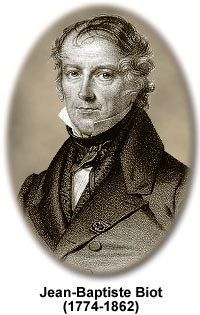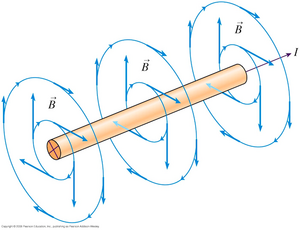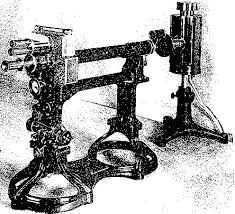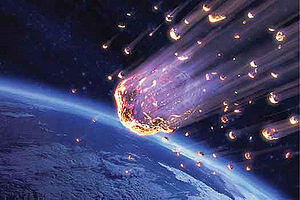Jean-Baptiste Biot
Claimed by Jin Soo Kim(jkim3096)

Personal Life
Jean Baptiste Biot was born in Paris, France on April 21, 1774 and died on February 3, 1862 when he was 88 years old in Paris. He started his study from the College of Louis-le-Grand and then joined army in 1793. He left the service to finish his education at École Polytechnique in 1794. Later, he was appointed as a professor at the University of Beauvais in 1797. In 1800, he came back to Paris as a mathematical physics professor at Collège de France and was elected as a member of the French Academy of Sciences in 1803. He was also elected as a foreign member of the Royal Swedish Academy of Sciences. He won Rumford Medal for his research on polarization of light in 1840. He had a single son, Édouard Constant Biot, in 1803. His son died in 1850. Jean Baptiste Biot was very religious throughout his life. He studied astronomy, elasticity, electricity, magnetism, heat and optics.
Scientific Contributions
Biot-Savart Law

Jean-Baptiste Biot discovered Biot-Savart Law with Felix Savart in 1820. They ran current through a wire and distant needle moved. In electromagnetism, Biot-Savart Law relates magnetic fields to the electric current or moving charge. Moving charges or electric currents create curly magnetic fields around the path. Biot-Savart Law calculates magnitude and direction of the magnetic field. Magnetic field is measured in tesla. The general formula for a moving single charge is  . The general formula for a short thin length of wire is
. The general formula for a short thin length of wire is  . [math]\displaystyle{ \hat{r} }[/math] vectors in both formulas are pointing from the point charge and wire.
. [math]\displaystyle{ \hat{r} }[/math] vectors in both formulas are pointing from the point charge and wire.
Biot also rose to a height of 13,000 feet on the first scientific hot-air balloon ride with Gay Lussac to study magnetic field at different atmospheres. He found that magnetic field is not affected by elevation.
Saccharimetry

He also formulated Saccharimetry which demonstrated implementation of Optical Physics to Chemistry. While studying polarized light, he found that the sugar solution rotates the plane of polarization when a polarized light beam passes through, and angle of rotation has direct relationship with the concentration of the solution. The more the angle rotates, there is higher concentration of substance in the solution. His new finding connected him with Louis Pasteur. Saccharimetry is widely used in food and pharmaceutical industry. This new method allowed calculation of concentration of the solution without damaging the solution.
His study of optics and polarization led to inventions such as LCD (Liquid Crystal Displays).
Meteorites

Biot also had contributions in astronomy. He was sent by France Academy to investigate 3,000 meteorite pieces that fell on L'aigle, France. He assisted Ernst Florens Friedrich Chladni's argument that meteorites are debris from the outer space. They proved their argument through thorough analysis of composition of the meteorites. This discovery led to accurate measurements of the chemical composition of outer space elements which gave clues modern scientists and astronomers how the solar system formed.
Other
Fun Facts
Jean-Baptiste Biot was also a good writer. He made many contributions in Literature such as Analyse de la mécanique céleste de M. Laplace.
There is a street named after him in Paris called Rue Biot.
See also
Further reading
http://micro.magnet.fsu.edu/optics/timeline/people/biot.html
http://www.astrotheme.com/astrology/Jean-Baptiste_Biot
http://physics.kenyon.edu/EarlyApparatus/Polarized_Light/Saccharimeter/Saccharimeter.html
External links
http://www.daviddarling.info/encyclopedia/B/Biot.html
https://www.upsbatterycenter.com/blog/jean-baptiste-biot/
http://www.pasteurbrewing.com/colleagues/biographies/jean-baptiste-biot-1774-1862.html
http://hyperphysics.phy-astr.gsu.edu/hbase/magnetic/biosav.html
References
1."Jean-Baptiste Biot". Encyclopædia Britannica. Encyclopædia Britannica Online. Encyclopædia Britannica Inc., 2015. Web. 03 Dec. 2015 <http://www.britannica.com/biography/Jean-Baptiste-Biot>.
2.Nat, Michael Vander. "JEAN BAPTISTE BIOT (1774-1862)." Pasteur Brewing. N.p., n.d. Web. 13 Feb. 2015.
3. Vernicu, Ionut. "Jean-Baptiste Biot (1774-1862)." - Biography, Life, Facts, About, Chronology, Timeline, People, Personalities, Celebrity, Birthday. Biography.name, 07 Sept. 2013. Web. 02 Dec. 2015.
4."Biot-Savart law". Encyclopædia Britannica. Encyclopædia Britannica Online. Encyclopædia Britannica Inc., 2015. Web. 03 Dec. 2015 <http://www.britannica.com/science/Biot-Savart-law>.